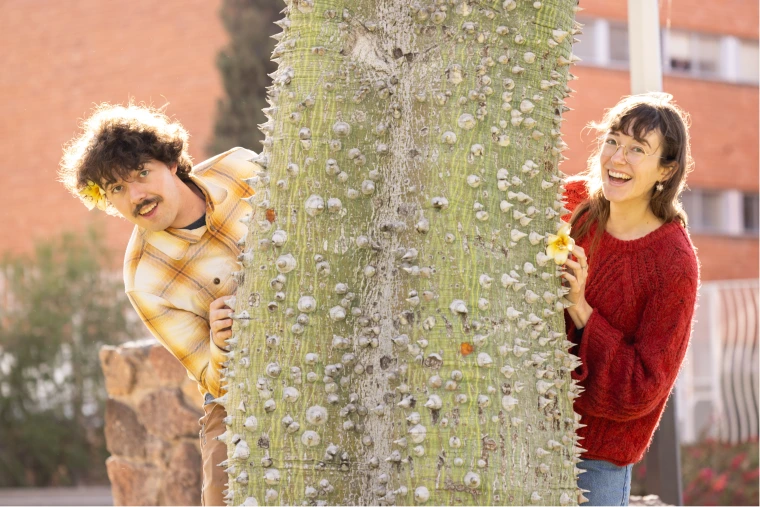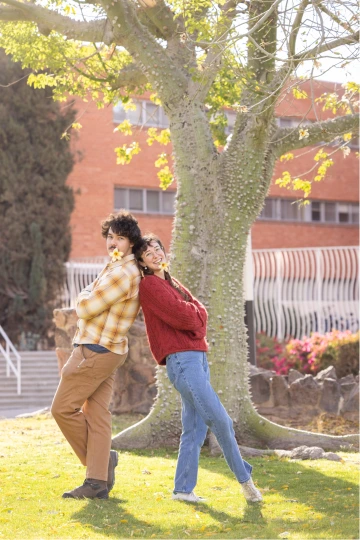Daniel, Chloe and the bunya-bunya
A tale of love, loss, and some truly enormous pinecones.

Chloe Penna ’23 was just 18 when she saw it: A tall, pinelike tree just south of Yuma Hall on the University of Arizona campus. She was taking a walk during the height of the coronavirus pandemic, trying — as we all did — to not lose her mind. “It was beautiful,” she says. “It was enormous. And it didn’t look anything like any of the other trees around.”
The walks went on. That time went on, really, longer than any of us expected. “And I would always stop by the tree and look for cones. I did that every day for months. It was a way to ground myself,” she says. “I would go and check in with the tree.”
Enter Daniel Collazo ’22. Daniel was working as a compost specialist with the U of A Office of Sustainability while getting a degree in molecular and cellular biology. “We initially met in the [U of A] Community Garden,” he says, which Chloe ended up managing for three years while pursuing a double major in English and Professional & Technical Writing. “A lady walked up to me while I was getting stuff out of a big storage container, and we just started talking.”

Talking led to walking, and walking led back to this tree, which, by the way, is called a bunya-bunya. An Australian conifer. Originally a houseplant, actually, set amongst the incredible diversity of specimens that make up the university’s Campus Arboretum, far from its native home but thriving nonetheless.
“I’m on my first date with this guy,” Chloe says, jerking her thumb at Daniel. “And we’re walking around at campus at, like, 7 or 8 A.M., and I’m showing him all of my favorite trees and all my favorite spots, and he’s showing me all of his favorite spots. And I take him to the tree and just tell him about it and why it’s so special.”
The bunya-bunya visits became a habit. “Whenever we would come to campus, we’d always walk by the tree,” Chloe says. “It was just part of my routine. This tree I love so dearly.”
July 2024 brought one of the most devastating monsoons in recent history. Roofs were ripped off buildings and homes, walls blown out, power lost, and more than 80 trees across the U of A campus were uprooted or destroyed. Trees that had in some cases been on campus for more than 80 years. The bunya-bunya was one of them.
Daniel kept it to himself for a day before telling Chloe. “By the time we got there, the tree was gone. It was just a stump,” she says. They stood quietly with a candle and grieved. “We had a good three and a half years.” What does it mean to love a tree? Just as much as it means to love anything, really: a pet, a friend, a familiar marker in the scenery of your life.
“I do have a list of my other favorite trees on campus,” Chloe says. The Chinese pistache tree outside the Cesar Chavez Building. The silk floss trees, one of which is on a lawn just south of the university gates. But loss is loss, and grief takes time.
And then: “I don’t know if we should mention that we did just get engaged a month ago,” Chloe says. You should! Mention it! Shout it from the rooftops! “I’d been thinking, ‘Oh, the tree — that would be a good spot for that to happen.’ But it didn’t work out like that. But it was OK. Happened in Central Park.”
She thinks back to the day she found her first bunya-bunya cone, in the summer of 2020. “It was just a terrible time in the world. Everything was so bad. It was so hot. It hadn’t rained in months. There were fires in the mountains and Oro Valley. Things were so bleak.” Then, out on one of her morning walks, there it was: A huge cone, about the size of her head. Ten pounds. “It was sort of the coolest day of my life. Just pure exhilaration to have finally found what I’d been looking for for so long,” she says. She brought it home, where she took approximately a million pictures, then put it on display on her nature shelf. It’s still there.
